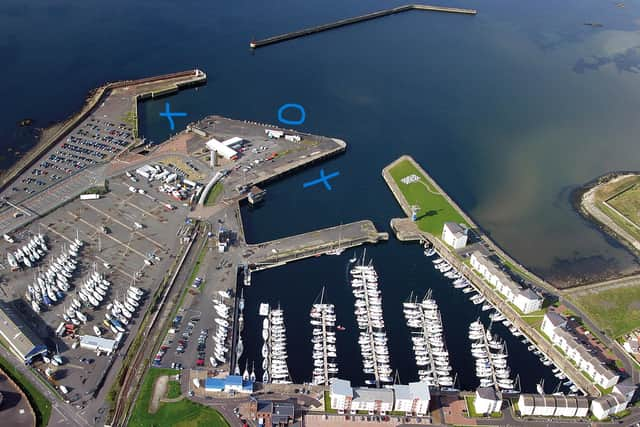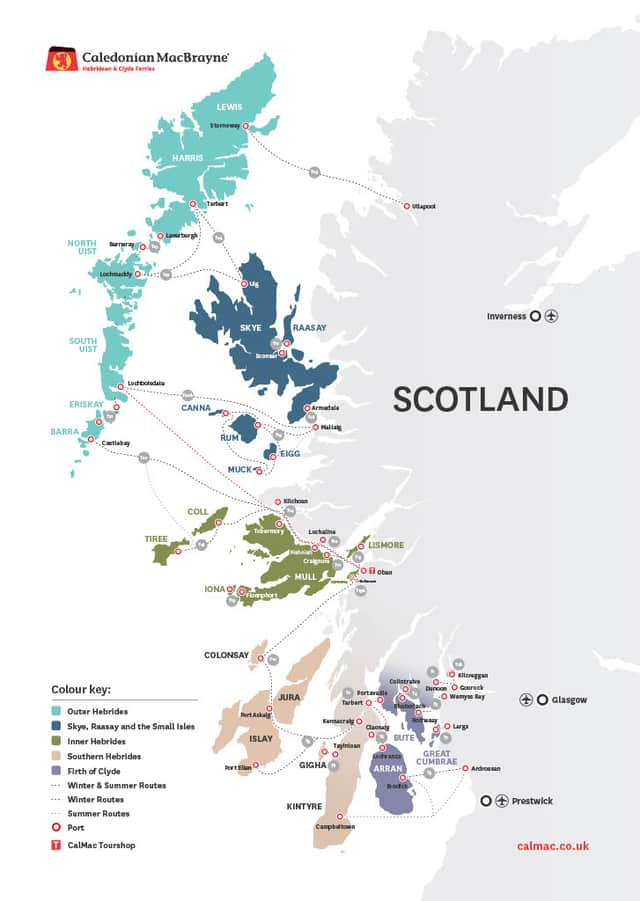CalMac crisis: Chief executive Robbie Drummond condemns ‘chaos’ caused to its busiest Arran route by ‘absolute failure’ at Ardrossan port
It should have heralded the start of the desperately-needed and biggest rejuvenation of the ageing CalMac fleet for decades.
But instead of ushering in any new ships, the summer season is approaching for Britain's largest ferry operator with engineers crawling into the bowels of one of its major vessels to complete an unexpected and lengthy repair, while a port on its busiest route will be unusable at times because it is in such a dilapidated state.
Advertisement
Hide AdAdvertisement
Hide AdA brighter future for CalMac seems to be forever on the horizon, with uncertainties over the completion of its next big vessel, Glen Sannox, which is already six years late, meaning it hasn’t even been factored into the operator’s winter plans, let alone its revised summer timetable, which is due to be published this week.


The Ferguson Marine-built vessel could yet be in service on the main Arran route in August, and is due to be followed by two Turkish-built ferries for Islay around December and next April, and Glen Sannox’s sister ferry Glen Rosa later next year.
However, CalMac chief executive Robbie Drummond’s past warning that things would get worse before they got better has been realised again. With the fleet “already stretched to the absolute limit”, the 1,000-passenger Caledonian Isles will now be out of action until at least mid-June for significant steel repairs.
Mr Drummond revealed to Scotland on Sunday that this had triggered checks on other ferries for similar problems, which meant there was a risk another vessel could also be taken out of service, compounding the disruption.
One third of the CalMac fleet is beyond its 30-year life expectancy, with the number of sailings cancelled by technical problems more than doubling last year. There were 3,825 between January and September alone, according to the latest available figures, compared to 1,879 in the whole of 2022 and 1,563 in 2021. The total was just 217 in 2010.


2023 was also the first time for years that breakdowns outweighed weather cancellations, which totalled 2,116.
The impact of 31-year-old Caledonian Isles' repairs on the main Arran route it serves, which is CalMac’s busiest with some 700,000 passengers a year, has been compounded by the state of Ardrossan harbour, its mainland port.
Ironically, because one of Ardrossan’s two berths is now out of action, the Alfred ferry charted last year to provide CalMac with a much-needed extra vessel is now unable to use the port to operate the route to Brodick.
Advertisement
Hide AdAdvertisement
Hide AdThe catamaran is due to start operating from Troon from Tuesday, but the port has no adjacent station for foot passengers. Being 15 miles further down the Clyde coast, it also means longer sailing times, and reduced frequency and capacity.


Mr Drummond’s increasing irritation at the situation in Ardrossan was evident in a choice of words normally avoided by transport chiefs.
He said: "The Irish berth is closed, which means in easterly-type weather we’re having to relocate to Troon – and that’s what’s happening this weekend and we are in chaos again. This is an absolute failure of critical infrastructure.”
Ardrossan harbour owner Peel Ports has blamed delays to its upgrade on “endless tinkering” by the Scottish Government.
But Mr Drummond said: "The problem is you’re moving five sailings [a day] from Ardrossan to three sailings from Troon because of the extended sailing times, so there is less capacity available, so we end up cancelling passengers."


Meanwhile, Isle of Arran, the 41-year-old other vessel on the route, is unable to use the remaining Arran berth at Ardrossan in certain weather conditions and will itself have to be switched to Troon – such as this weekend.
A further constraint caused by Alfred’s loading ramp means it won’t be able to take camper vans and low cars until modifications are made in about a month.
Mr Drummond said the situation contributed to a “really challenging summer and for Arran particularly”. He has already warned of sold-out sailings on the route.
Advertisement
Hide AdAdvertisement
Hide AdHe said: "While Arran is certainly going to be down on capacity, we believe we will be able to deliver the bulk of what the island requires, albeit it’s going to be very, very tight at peak periods.
"On the peak summer weekends and peak times at Easter, sailings will be very difficult, so we are trying to spread that traffic across the week."
CalMac will seek to persuade some passengers to switch to the underused Claonaig route to Lochranza on the other side of Arran, but Mr Drummond acknowledged it was a much longer drive, being three times as far from Glasgow as Ardrossan.
But it has cancelled its Ardrossan-Campbeltown route for a second year because of the vessels crisis.
The operator is considering a further fleet merry-go-round to increase capacity by switching the larger Hebrides ferry to the main Arran route from the Harris-North Uist-Skye triangle.
It would in turn be replaced by the Barra route’s Lord of the Isles, if berthing trials at the upgraded ports on the triangle are successful on Monday. Barra would get Isle of Arran from the main Arran route, which Mr Drummond said islanders would regard as a smaller and less capable vessel but which he said would offer a “resilient” service.
In a further move, to stave off overcrowding, Islay’s main ferry Finlaggan has had its annual overhaul postponed from last week until after Easter and be due back in time for the Feis Ile festival in May, temporarily reducing capacity while another vessel stands in.
Despite his frustration at the constant juggling, Mr Drummond said: "Everyone’s up for it and we are absolutely doing the best we can for customers and will deliver the best service we can.”
Advertisement
Hide AdAdvertisement
Hide AdBut without any spare ferries, another major breakdown could be hugely problematic. He said: "Our one resilience vessel, which was the Alfred, is now being fully deployed so we now have no spare vessels again. If any other vessels come out for a long period, that is going to be very difficult to cover.”
For now, Caledonian Isles is CalMac’s biggest headache. During its three-week annual overhaul in January, a scheduled inspection of a “coating breakdown” in a ballast tank under the engine room found “steel wastage” that became more extensive the more was checked, and requires some £5 million of repairs.


CalMac fleet management director Craig Ramsay told Scotland on Sunday the extent of the work was still being assessed, which had been hampered by access restrictions that had required engineers to crawl through 2ft diameter gaps. Some 20 holes have now been cut in the hull.
The ship also had to be moved from Greenock to Birkenhead so other ferry refits were not delayed.
Mr Ramsay said: "As we dig further into this, the work scope continues to grow. Within the next two weeks, we will have a much more accurate indication of what we’re dealing with in terms of time frame and cost.
"If we had the ability to easily survey these spaces to a high degree of confidence, we wouldn’t be here.”
However, he said completing the job by mid-June “will be challenging”.
Other ferries will now receive detailed checks while still in service to avoid a repeat. Mr Ramsay said: "The key is getting to a stage of completely understanding the vessel conditions so we can plan accordingly and not be caught short by emerging issues at the eleventh hour.”
Advertisement
Hide AdAdvertisement
Hide AdBill Calderwood, secretary of the official Arran Ferry Committee, said the busiest route on CalMac’s network was “being left to cope with the oldest vessel and a leased vessel which has limited flexibility”.
He said: “The rest of this year will be very challenging for the community who will work to ensure that visitors are welcomed in our usual manner but we cannot just accept that challenge and will continue to push for further efforts from all parties to seek alternatives."
David Henderson, the National Farmers Union of Scotland representative on the committee, said: “The reputational damage to the island is incalculable. The first thing folk say to you when you say you are from Arran is ‘Oh, how did you manage to get off the island’.
"It’s like a lottery - Will I get booked? Will I be sailing from Troon or Ardrossan? Will it break down? What boat will it be? Will my booking still stand?
"We are struggling to get cattle and sheep off the island to markets as boats are fully booked. We can’t ‘just go another day’ as the marts are only on one day a week so we need to go on specific days.
“The front line staff at Ardrossan and Brodick are first class but they get a whole load of grief for decisions they have no part in taking.”
Angus Campbell, the Lewis-based chair of the CalMac Community Board, said: “The lack of investment in the fleet over many years has left the network in a position that continual vessel failures leave many communities with significantly reduced service, resulting in serious social and economic damage to our already fragile islands.
“The board has urged Mr Drummond to further examine all options including enhancing timetables. The situation is so serious in islands such as Arran that any marginal gain or improvement must be grasped to alleviate the damage caused."
Comments
Want to join the conversation? Please or to comment on this article.